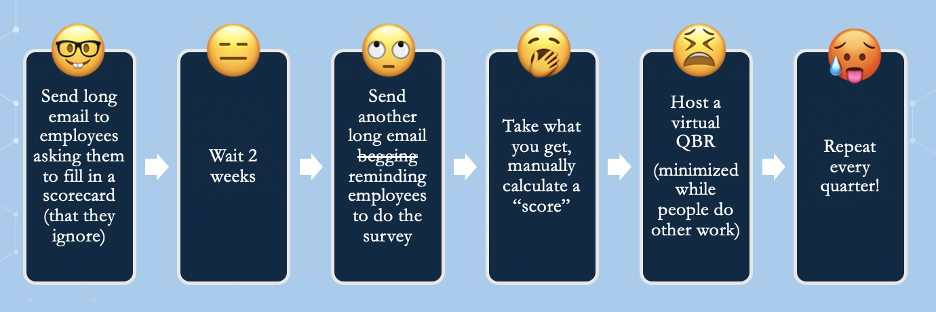Why Spend Matters analysts love SupplyHive (and think you should too)
Did you know that Microsoft released the first version of Excel around this time in 1985? Do you know what else was released in 1985? The compact disc! Do you know what has gracefully lived its technological life and gone over the rainbow bridge to hang out with discmen and 8-tracks and even iPods in digital heaven? CDs. Do you know what has not? EXCEL.
Why do we still kill ourselves with macros and pivot tables and version control? Since we’re talking about rating suppliers today, let’s take a look at the typical process:

Here comes some analyst-speak: “Aware that procurement organizations have handled essential [supplier ratings] in the supplier management process either through minimally supportive survey functionality in P2P and S2P suites or, more commonly, through enormous spreadsheets, SupplyHive set out to create a tool for evaluating employee satisfaction with suppliers that could gather and analyze needed data about supplier performance while offering a streamlined, B2C-like consumer experience.”
As a quick run-down, here’s why Spend Matters thinks getting supplier rankings out of Excel is a critical switch to drive digital transformation, not just for procurement departments, but also for business units (Marketing, HR/Benefits, Legal, IT, we’re looking at you), supplier diversity initiatives (more on that in a future post) and for C-Suites and boards (we’ll talk about that later too):
- The obvious: time, money, energy, accuracy. Suppliers on average are the biggest line-item on a company’s budget sheet. An average supplier manager can spend up to twelve hours per quarter preparing for a single quarterly business review. Reviewers who are time pressured to review on deadline give low quality reviews just to get it done.
- 360-degree feedback. Shouldn’t suppliers rank you too, as a customer? Shouldn’t ranking questions and criteria change over time, as your relationship evolves and matures? Shouldn’t new employees be able to see the history of a relationship over time? Yes, yes, and yes. “SupplyHive subscribes to the philosophy that gathering and managing performance-related information (e.g., basic supplier info, performance metrics, action plans) does not constitute true supplier relationship management; rather, the process of gathering, measuring and managing feedback (from both sides of the relationship) is fundamental to nurturing and improving a relationship (or, in worst-case scenarios, in determining whether it’s time for a breakup).” Note: EXCEL CAN’T DO THIS. It’s about driving engagement and getting all stakeholders excited to participate because, after all, the more relevant data you can get from the business, the more effective they become within their work.
- It’s pretty: The SupplyHive approach to UX/UI development almost religiously focuses on being as modern and user friendly as possible. Its dashboard is not really an enterprise software dashboard; instead, it is sleek, modern and interactive. Beyond visual elements alone, SupplyHive also puts a smart focus on applying automation where appropriate: automatic reminders to reviewers when a review is incomplete and automatic aggregation and summary of reviews and sentiment into a shareable, media-like format if you’re not an informational designer (we’re not, and assume you likely have better things to do). SupplyHive thereby eliminates the tedious, time-consuming process of supplier review, which frees up sourcing professionals’ time to do what they do best—making strategic decisions, solving problems, and exploring innovations with suppliers to deliver value to their organization.
While assessing the health and performance of a business relationship that could account for millions of dollars of spend is, of course, not a simple task, the approach that many organizations take to executing these reviews is not necessarily wise. It’s time for a change, folks. SupplyHive allows you to have positive and dynamic engagement with your suppliers throughout the lifecycle of these relationships to proactively identify corrective actions, strengthen the relationship via transparency, and drive innovation between you and your supplier partners.
Portions of this article are quoted from independent Spend Matters PRO coverage of SupplyHive. Spend Matters was in no way paid to say nice things about SupplyHive. Spend Matters PRO subscribers can read the full analysis (including a detailed SWOT dive into product strengths and weaknesses) here: Part 1 / Part 2